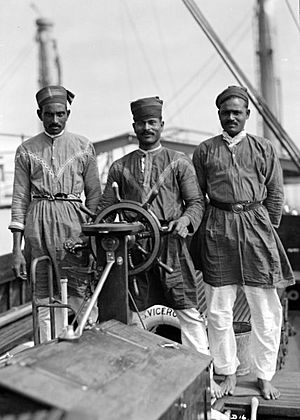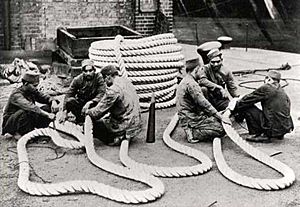Lascar facts for kids
A lascar was a sailor or soldier from places like India, Southeast Asia, the Arab world, or British Somaliland. These sailors worked on European ships from the 1500s until the mid-1900s. They were an important part of sea travel and trade for many centuries.
Contents
What Does "Lascar" Mean?
The word "lascar" comes from an Urdu word, lashkar, which means "army" or "camp." It was also used for "lashkarī," meaning a soldier.
The Portuguese first used a similar word, "laschar," around 1600. They used it to describe Asian soldiers or sailors from anywhere east of Cape of Good Hope. The British later started using the term "lascar" too.
Sometimes, the word "lascar" was also used for Indian servants who worked for British military officers.
A Look Back: History of Lascars
Early Days (1500s)
Indian sailors were working on European ships even before the 1500s. When Vasco da Gama became the first European to reach India by sea in 1498, he hired an Indian pilot. This pilot helped steer his ship across the Indian Ocean.
Portuguese ships hired many lascars from places like Goa in India. They called all sailors from the "Indies" (lands east of the Cape of Good Hope) "lascars."
Some Indian lascars even ended up on British ships. They were among the first sailors on the East India Company ships sailing to India.
The 1600s
When the British started using the word "lascar," it first meant all Asian crewmen. But after 1661, it mostly meant sailors from East India.
Many European sailors got sick or ran away in India. This left ships without enough crew for the journey back to Europe. Also, during wars, the Royal Navy often took British sailors from Company ships. Because of this, the British needed more lascars.
The British tried to limit the number of Indian seamen on their ships. Laws called the Navigation Acts said that 75% of a British ship's crew had to be British. But the need for lascars continued to be high.
The 1700s
Lascars played a role in military actions. For example, in 1756, a British fleet had 300 'topaze Indo-Portuguese' soldiers. These were Indian soldiers who helped the British.
Lascars also served with famous leaders like the Duke of Wellington in India.
After long voyages, many lascars were left in London. In 1786, a group called the Committee for the Relief of the Black Poor was set up to help them.
Lascars were paid much less than white sailors, sometimes only half their wages. They often worked longer hours and received less food, which was sometimes not very good quality. Shipowners could keep them working for up to three years, moving them from one ship to another. This was a very difficult life for them.
The 1800s
The East India Company hired sailors from many parts of Asia, including Bengal, Assam, Gujarat, Yemen, and Goa. These sailors, known as lascars, continued to work on British and European ships until the 1960s.
Many lascars visited British port cities. Between 1803 and 1813, over 10,000 lascars came to Britain. By 1855, this number grew to 12,000 each year. Some lascars settled in these port towns. They often stayed because of strict laws or because they were left stranded. Many faced poverty. They sometimes lived in charity homes or boarding houses.
By the start of World War I, over 51,000 Indian lascars were working on British ships. Most of them were from Bengal.
It was hard for officers and lascars to understand each other because of language differences. So, translators were very important. Often, native bosses called "serangs" (like a boatswain) and "tindals" helped communicate. They were the main people who spoke for the lascars.
Lascars also served on ships that carried people to Australia. They worked on troopships during Britain's wars, like the Boer Wars. In 1891, over 24,000 lascars worked on British merchant ships.
In 1815, new rules were made to help lascars. They were supposed to get a bed, a pillow, two jackets, trousers, shoes, and two woollen caps.
The 1900s
Lascars worked all over the world before World War I. Some ports, like in British Columbia, did not allow them to land.
In World War II, thousands of lascars served and died on ships around the world. Many worked for British shipping companies. Even though they served bravely, some were not given the medals they earned.
The term "lascar" became less common after the 1950s, as the British Empire ended. The Indian “Lascar Act” of 1832, which had rules about lascars, was finally removed in 1963.
Lascars in Britain
Lascars started living in England in small numbers from the mid-1600s. They worked as servants and sailors. More lascars arrived in the 1700s and 1800s. The British East India Company hired thousands of them to work on ships and in ports.
Despite facing challenges and language barriers, some lascars settled in British port cities. They were sometimes forced to stay due to poor treatment or laws that made it hard for them to leave. Shipowners could face fines for leaving lascars behind.
Lascars often lived in charity homes or boarding houses. Some married local British and Irish women. This led to small mixed-race communities in port towns. One famous example was Sake Dean Mahomed, who married an Irish woman.
Lascars often faced poverty in Britain. Reports from the 1780s described them "shivering and starving in the streets." The East India Company tried to help by providing lodging, but these places were often crowded and dirty. Many lascars died each year due to these terrible conditions.
In 1856, "The Strangers' Home for Asiatics, Africans and South Sea Islanders" opened in London. This home helped lascars and other sailors. It offered a place to stay, helped them find jobs, and allowed them to send money back home.
In 1925, a law called the Coloured Alien Seamen Order 1925 Act made it harder for non-white sailors to live in Britain. Even if they were British subjects, they often had to register as "aliens" with the police. This led to unfair treatment and made it difficult for them to stay.
People like Surat Alley fought for the rights of lascars in Britain during the 1930s and 1940s.
Lascars in Other Places
Lascars were also on ships arriving on the Pacific coast of North America in the late 1700s. They were part of diverse crews looking for furs. However, lascars were later not allowed to enter places like British Columbia from 1914 until the late 1940s. They would stay on board their ships when in port.
Lascars arrived in Hong Kong even before 1842. Since Hong Kong was a naval base, Indian lascars from the East Indies Fleet came there. There are even streets in Hong Kong called Upper Lascar Row and Lower Lascar Row, named after them.
Lascars were also on early British voyages to the north-west coast of North America. In 1786, the ship Nootka had ten Indian and one Chinese lascar. These lascars were the first recorded Indians to sail to places like Alaska and Hawaii.
What Jobs Did Lascars Do?
Lascars worked under special "lascar agreements." These agreements gave shipowners a lot of control. Sailors could be moved from one ship to another and kept working for up to three years.
On ships, lascars had different roles:
- Serang: This was the head of the lascars, like a boss or foreman.
- Tindal: These were assistants to the serang.
- Seacunny: A sailor who helped steer the ship.
- Mistree: A carpenter.
- Kussab or Cassab: A person who took care of the ship's lamps.
- Topas or Topaz: An apprentice or trainee.
- Butler: The senior lascar in charge of food and catering.
- Bhandary: A cook.
Lascars in Books and Movies
Lascars have appeared in many stories:
- Sir Arthur Conan Doyle wrote about a lascar in his Sherlock Holmes story "The Man with the Twisted Lip".
- In Joseph Conrad's novel Lord Jim, lascars on the ship Patna are important characters.
- Frances Hodgson Burnett's book A Little Princess features a lascar named Ram Dass.
- In Wuthering Heights, some people think the main character, Heathcliff, might have been of lascar origin.
- Amitav Ghosh's book Sea of Poppies shows the British East India Company and their use of lascar crews.
- Shahida Rahman's book Lascar (2012) tells the story of an East Indian lascar's journey to Victorian England.
- In H. P. Lovecraft's short story The Call of Cthulhu, two "lascar sailors" are part of a mysterious cult.
- Ken Follett's A Place Called Freedom also mentions lascars.
Images for kids
See also
- Lascar Row
- Lascar War Memorial
- Lascarins
- Askari
- Sepoy
- Sake Dean Mahomed
- First Anglo-Afghan War
- Visa policy of the United Kingdom




